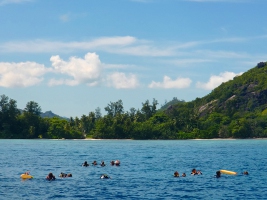 |
| Filling tanks for the day's dives |
This past week was full of wonderful experiences, punctuated with a Hawaiian themed Friday night BBQ. I made the most of every moment, embarking on the '
Marathon Snorkel', scouring the reef for megafauna, and celebrating this wonderful world by diving for
Earth Day and conducting a beach clean. Amidst all the oceanic adventures, I managed to pass both coral identifying exams and have made headway in my
BTEC Biological Survey Techniques and
Team Leading courses. It was another full week, but I'd have it no other way.
Not wishing to let the weekend slip idly by, I set forth on a solo
snorkel adventure around the northwestern tip of
Bay Ternay and down the channel to
Anse Souillac, referred to as 'Back Beach'. The journey took an epic 3.5 hours to complete and is affectionately referred to as the Mega or Marathon Snorkel on base.
 |
| A Hawksbill turtle meanders about the reef |
Though it was the furthest (3.5 miles) and longest I'd ever snorkeled before, the time flew by as I was entranced with the underwater world teeming with life. Schools of fish shimmered past, their dynamic formations sparkling underwater as they darted past me. A
humphead wrasse, larger than myself lazily swam below me, dwarfing all the other fish. I was even fortunate enough to swim along with a
Hawksbill turtle for a while, doing my best to not draw attention to myself. When the turtle did see me, it sped off behind me toward deeper waters- and that's when I saw the massive barracuda that had been following me for who knows how long... he was enormous, just shy of 2 meters, and watched me intensely with its beady eyes. It took a lot of nerve to keep my wits about me, but I just kept swimming and eventually snorkeled to Back Beach without incident. I did suffer from cramps in both feet along the way, but a little free floating was a quick remedy to the pain. Embarking on the snorkel was the perfect way to begin the week.
 |
| Massive barracuda and a Hawksbill turtle below |
The days rolled along as the rigorous schedule settled into everyone's system and routines established. Wednesday's turtle dive was a futile attempt at finding turtles for my dive buddy and I, but we had the opportunity to explore a new area of Bay Ternay. The drop off point was quite deep and the water much more turbid than where we've been conducting Coral Spots and skill dives. After descending to 16 meters, the bottom was nowhere to be seen- so my buddy, Dan, and I marked the bearing for shore and started our U-Pattern in hopes of reaching shallower, clearer waters. After, 20 minutes of navigating darkness, we found the edge of the reef and the ocean suddenly came to life. Delicate corals decorated the substrate as colorful fish swam above, foraging for food. Though we did not see any turtles, we caught a glimpse of a moray eel as it peeked out its head from a small crevice, which made the turtle dive a success in my book!
 |
| View of the Lighthouse from the ocean |
We celebrated this beautiful world by conducting a reef clean in conjuction with
Project AWARE's Dive for Earth Day 2011. In teams of 4, we set out in search of rubbish on Mahe's NW reefs. While scouring the reef for garbage, my team was fortunate enough to see an impressive number of megafauna (almost overshadowing our main purpose); 3
thornback rays sifted through the sands searching for food, a
moray eel popped out of an under-hang to say hello as a
lion fish flared its fins, and a
rock fish nearly fooled us for being part of the substrate just before our ascent. It was one of the most fun and fulfilling dives I've been on yet!
 |
| Just a sample of garbage collected for the day... |
Setting aside our dive kits and smeering on half a bottle of sunscreen, we continued our Earth celebration on the beaches near base. We set out with large sacks and combed the beach front for garbage. Considering the remote location, I was astounded by the vast amount of waste which we collected- everything from shoes and bottles to a lightpost and even a rake! We filled all of our sacks and sent them off to the
Marine Parks Authority to be sorted and disposed of properly.
 |
| I ♥ Friday Night BBQ! |
I've made progress in my aim to identify corals on sight and earn my BTEC certifications this week. In order to become qualified to survey our coral monitoring sites, every individual must pass two coral exams in conjunction with correctly identifying corals proficiently on Coral Spot dives. We've had two coral exams this week, and I was able to pass both (95% or higher is required to pass). So, with a little luck and focus, I'll be out monitoring sites by the end of next week or so...
But, even if it takes a little longer, I'll have my hands full as my two BTEC have begun. By the end of my first 10 weeks here, I should have a BTEC Biological Survey Certification and Level 2 BTEC Award in Team Leading. These will be time intensive but relevant courses to my work here, affording me the opportunity to lead a survey dive and put my biological survey skills to the test in open waters.
SSJHXFVNFZX4

















